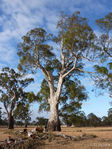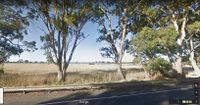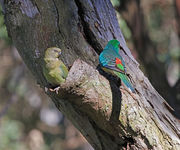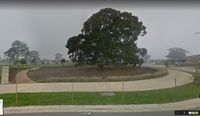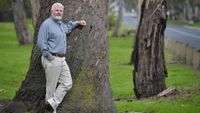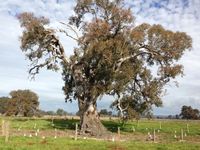Native trees in agricultural landscapes - Melbourne - Australia: Difference between revisions
(Created page with ">>>''Back to Case Studies Overview'' >>>'''Add here a title for your case''' {| align="right" width="300pt" style="background:Gainsboro;...") |
|||
| (25 intermediate revisions by the same user not shown) | |||
| Line 37: | Line 37: | ||
==Why is this case relevant?== | ==Why is this case relevant?== | ||
River Red Gums (Eucalyptus camaldulensis) form an integral part of the identity of agricultural landscapes on the urban fringe of southeast Melbourne. Often they are the only obvious link with the pre-European settlement landscape. Aborigines once used their wood for tools and canoes. In early stages of Melbourne's development as a city, their wood was highly regarded for its durability and used for example in the construction of Melbourne's wharves. Farming took over the cleared land and today only scattered trees remain. It thus forms a link between landscape and local history. These scattered trees can be up to 500 years old and 30m high, providing great aesthetic interest in an otherwise generic landscape of pasture and fences. As trees mature, they form large hollows which are critical resources for rare wildlife. Many trees are dying as they age and do not regenerate naturally because of cattle grazing (Robertson and Rowling 2000), so that without intervention this landscape will be lost. | |||
==Which idea of ‘design with nature’ guides the design concept of this site?== | ==Which idea of ‘design with nature’ guides the design concept of this site?== | ||
*''In this section you talk about the design concept of your area. Is it a highly maintained site, i.e. does the design with nature require intensive maintenance? Or does the site follow a more organic interpretation of nature? Which changes are expected if maintenance is missing?'' | *''In this section you talk about the design concept of your area. Is it a highly maintained site, i.e. does the design with nature require intensive maintenance? Or does the site follow a more organic interpretation of nature? Which changes are expected if maintenance is missing?'' | ||
This landscape is the result of of past land clearing and is currently not intensively maintained for its long term character. If maintenance continues to be absent, many of the remaining trees will disappear in the next decades due to natural death and damage from storms. Most existing trees predate European settlement of the area in the 1850s, with very few growing in the time since then. | |||
== Which challenges is this landscape facing?== | == Which challenges is this landscape facing?== | ||
*''Here you discuss the types of negative impact you are observing but you can also mention new functions that could give a development opportunity'' | *''Here you discuss the types of negative impact you are observing but you can also mention new functions that could give a development opportunity'' | ||
This landscape is facing rapid change as its last remaining large trees almost completely disappear in coming decades. What is needed is the protection of remaining trees from short-sighted development, and the regeneration of the population using locally sourced seed. This has happened in a few isolated cases, such as a new residential development which designed streets and a golf course to incorporate the trees. However, in the broader agricultural landscape the decline is unabated. | |||
== What would be your strategy for improvement?== | == What would be your strategy for improvement?== | ||
A possible development opportunity may exist in providing incentives for landowners to conserve large river red gums, in particular fencing them off from cattle so that seedlings can grow around existing trees. | |||
[[#toc|'''Back to top''']] | [[#toc|'''Back to top''']] | ||
| Line 53: | Line 55: | ||
<gallery caption=" " widths="200px" heights="150px" perrow="4"> | <gallery caption=" " widths="200px" heights="150px" perrow="4"> | ||
Big-Red-Eucalyptus-camaldulensis-gum.jpg | Large River Red Gums are an iconic image of floodplains used for agriculture in southern Australia. They can grow to be 30m tall and 500 years old. (http://www.dn.com.au/Big_Famous_Trees_gallery/pages/Big-Red-Eucalyptus-camaldulensis-gum.html) | |||
RRG_ThomsonsRd_StreetView.jpg | River Red Gums in cattle fields south east of Melbourne | |||
Image: | Image:Psephotus_haematonotus_-Crestwood_Reserve,_Baulkham_Hills,_Sydney,_Australia_-pair-8.jpg | Tree hollows provide habitat for many native mammal and bird species (https://commons.wikimedia.org/wiki/File:Psephotus_haematonotus_-Crestwood_Reserve,_Baulkham_Hills,_Sydney,_Australia_-pair-8.jpg) | ||
GoogleAerialPhotoSandhurst.JPG | Scattered River Red Gums in fields on the boundary of Melbourne's urban fringe | |||
RRG_BarringtonChase_StreetView.jpg | River red gums integrated into new residential development bordering farmland | |||
FrankstonEnvironmentalistsRRG.jpg | Environmentalists pressured state government road development authority to save 400 year old trees during a road widening project (https://www.heraldsun.com.au/leader/south-east/frankston-environmentalists-join-campaign-to-save-string-of-400yearold-river-red-gums/news-story/f33e871de6e22fd02187cfc0fb33eb64) | |||
Paddock-trees1.jpg | Fencing large old trees is important to allow regeneration to occur without trampling from cattle grazing (www.http://gretalandcare.org.au/projects/paddock-trees/) | |||
77a-cc-adding-logs-to-the-ground-layer.jpeg | Trees being replanted with fallen timber from a neghbouring field added as habitat (https://www.recreatingthecountry.com.au/structure.html) | |||
</gallery> | </gallery> | ||
| Line 67: | Line 69: | ||
== References == | == References == | ||
Robertson, A.I. & Rowling, R.W. (2000) Effects of livestock on riparian zone vegetation in an Australian dryland river. Regulated Rivers: Research and Management, 16, 527–541. | |||
https://www.heraldsun.com.au/leader/south-east/frankston-environmentalists-join-campaign-to-save-string-of-400yearold-river-red-gums/news-story/f33e871de6e22fd02187cfc0fb33eb64 | |||
---- | ---- | ||
Latest revision as of 20:19, 13 November 2018
>>>Back to Case Studies Overview
>>>Add here a title for your case
| Name | add the site name | |
| Place | add the city name | |
| Country | add the country | |
| Author(s) | add your name(s), optional | |
| World Heritage | if applicable,enter the year of listing | |
|
| ||
Why is this case relevant?
River Red Gums (Eucalyptus camaldulensis) form an integral part of the identity of agricultural landscapes on the urban fringe of southeast Melbourne. Often they are the only obvious link with the pre-European settlement landscape. Aborigines once used their wood for tools and canoes. In early stages of Melbourne's development as a city, their wood was highly regarded for its durability and used for example in the construction of Melbourne's wharves. Farming took over the cleared land and today only scattered trees remain. It thus forms a link between landscape and local history. These scattered trees can be up to 500 years old and 30m high, providing great aesthetic interest in an otherwise generic landscape of pasture and fences. As trees mature, they form large hollows which are critical resources for rare wildlife. Many trees are dying as they age and do not regenerate naturally because of cattle grazing (Robertson and Rowling 2000), so that without intervention this landscape will be lost.
Which idea of ‘design with nature’ guides the design concept of this site?
- In this section you talk about the design concept of your area. Is it a highly maintained site, i.e. does the design with nature require intensive maintenance? Or does the site follow a more organic interpretation of nature? Which changes are expected if maintenance is missing?
This landscape is the result of of past land clearing and is currently not intensively maintained for its long term character. If maintenance continues to be absent, many of the remaining trees will disappear in the next decades due to natural death and damage from storms. Most existing trees predate European settlement of the area in the 1850s, with very few growing in the time since then.
Which challenges is this landscape facing?
- Here you discuss the types of negative impact you are observing but you can also mention new functions that could give a development opportunity
This landscape is facing rapid change as its last remaining large trees almost completely disappear in coming decades. What is needed is the protection of remaining trees from short-sighted development, and the regeneration of the population using locally sourced seed. This has happened in a few isolated cases, such as a new residential development which designed streets and a golf course to incorporate the trees. However, in the broader agricultural landscape the decline is unabated.
What would be your strategy for improvement?
A possible development opportunity may exist in providing incentives for landowners to conserve large river red gums, in particular fencing them off from cattle so that seedlings can grow around existing trees.
Image Gallery
Large River Red Gums are an iconic image of floodplains used for agriculture in southern Australia. They can grow to be 30m tall and 500 years old. (http://www.dn.com.au/Big_Famous_Trees_gallery/pages/Big-Red-Eucalyptus-camaldulensis-gum.html)
Tree hollows provide habitat for many native mammal and bird species (https://commons.wikimedia.org/wiki/File:Psephotus_haematonotus_-Crestwood_Reserve,_Baulkham_Hills,_Sydney,_Australia_-pair-8.jpg)
Environmentalists pressured state government road development authority to save 400 year old trees during a road widening project (https://www.heraldsun.com.au/leader/south-east/frankston-environmentalists-join-campaign-to-save-string-of-400yearold-river-red-gums/news-story/f33e871de6e22fd02187cfc0fb33eb64)
Fencing large old trees is important to allow regeneration to occur without trampling from cattle grazing (www.http://gretalandcare.org.au/projects/paddock-trees/)
Trees being replanted with fallen timber from a neghbouring field added as habitat (https://www.recreatingthecountry.com.au/structure.html)
References
Robertson, A.I. & Rowling, R.W. (2000) Effects of livestock on riparian zone vegetation in an Australian dryland river. Regulated Rivers: Research and Management, 16, 527–541.

